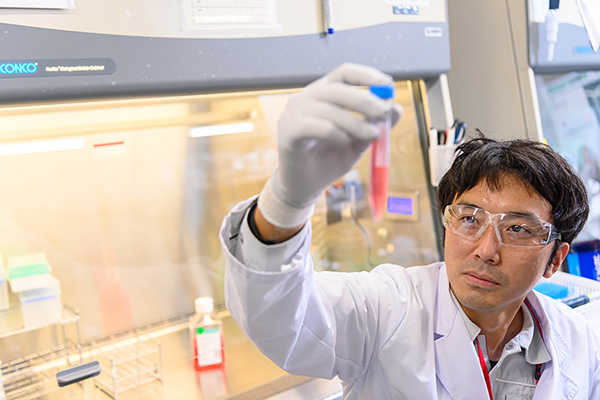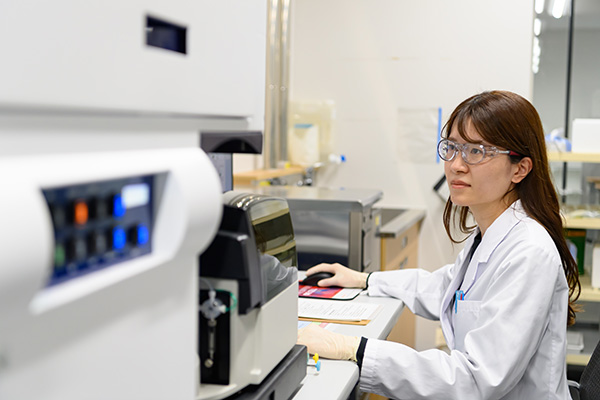Kyowa Kirin’s Initiatives
Aiming to improve the quality of life of patients
Kirin is developing three business domains: Food & Beverages, Pharmaceuticals, and Health Science. Kyowa Kirin, which focuses on the Pharmaceuticals domain, aims to create life-changing value that makes people smile, as they feel that their lives have improved dramatically.
To realize this goal, we are focusing on research in the areas of bone and mineral, intractable hematological diseases/hemato oncology, and rare diseases. We are committed to reducing the burden on patients to the utmost limit by addressing diseases for which there is still no effective treatment and promoting the development of new drugs.
In recent years, we have also been working to establish new therapies at the genetic level and utilizing cells themselves in order to provide more effective treatments in drug discovery technology. A single administration of a drug can lead to improve the treatment from the underlying cause of a disease. We believe that realizing such a solution will improve the quality of life of patients.
A New drug developed for a disease that had only been treated symptomatically. Great burden reduction on patients.

One of the efforts we made in the bone and mineral area is the development of a treatment for rickets and osteomalacia. Rickets and osteomalacia are diseases in which bone calcification (bone hardening) is disturbed, resulting in changes in bone shape and symptoms such as pain. When these symptoms are seen in children, it is called rickets, and when they are seen in adults, it is called osteomalacia.
Innovating the treatment of the intractable disease XLH
One of these diseases, XLH (X-linked hypophosphatemia and osteomalacia), is an intractable disease in which the kidneys over excrete phosphorus and vitamin D, which are necessary for bone formation, and interfere with bone growth and maintenance. It is a rare disease that affects approximately 1 in 20,000 people, and many patients suffer from growth failure.
Kyowa Kirin developed Crysvita for the treatment of this disease. In 2018, it was launched in the U.S. and parts of Europe and is now available in more than 50 countries and regions, including Japan.
Until then, the conventional treatment for XLH was symptomatic treatment with phosphorus and vitamin D supplementation. However, this treatment required multiple daily doses of medication and was associated with the side effect of renal calcification.
In contrast, treatment with Crysvita requires only one injection every two to four weeks. In addition, by increasing and maintaining blood phosphorus levels in the normal range, pain relief and improved bone growth can be expected. This has made a significant contribution to improving the quality of life of patients.
First in the world to discover that FGF23 suppresses excessive phosphorus discharge
The development of Crysvita began when we focused on phosphorus in the process of understanding bone metabolism.
Phosphorus is the second most important nutrient in the body after calcium and is the main component of bone and tooth formation. However, compared to calcium, research on how phosphorus is regulated in the body has not progressed much worldwide. Kyowa Kirin believed that there was an opportunity for new discoveries there.
In 2000, through research on diseases that cause low blood phosphorus, we discovered for the first time in the world that a hormone called FGF23 plays an important role in regulating phosphorus level in the body. However, although FGF23 has the ability to reduce phosphorus in the blood, it could not be used as it is as a drug.
Kyowa Kirin has been researching the phenomenon where suppressing the function of FGF23 increases the amount of vitamin D in the body, thereby reducing the excessive discharge of phosphorus from the kidneys. In order to suppress the function of FGF23, we used the fully human antibody production technology, a technology that reproduces a substance similar to antibodies produced in the human body. This technology has enabled us to develop a new drug called Crysvita.
Bringing light to incurable diseases. Development of Breakthrough Technology Establishes Cures for Rare Diseases

As exemplified by Crysvita, Kyowa Kirin has been developing new drugs based on a deep understanding and knowledge of how the human body works. Furthermore, in 2024, Kyowa Kirin acquired a position as a world leader in the field of gene therapy through the acquisition of Orchard Therapeutics ("Orchard"), a pioneer in gene therapy, as a wholly owned subsidiary.
We are advanced in the research and development of treatments that address the underlying causes of disease.
Tackling the Rare Disease MLD with New Drug Discovery Technology
A case in point is the development of a treatment for MLD (metachromatic leukodystrophy), a rare genetic disorder that causes neurological damage due to an enzyme deficiency. Until now, there has been no effective treatment for this disease, despite the fact that in severe cases, patients risk losing the ability to walk or speak and die within five years of the onset of the disease.
Orchard approached this challenge with its innovative drug discovery technology platform utilizing hematopoietic stem cells (the source of blood cells). Based on the platform, Orchard has successfully developed a treatment called Libmeldy/Lenmeldy by applying the properties of hematopoietic stem cells, which continue to produce new blood cells at various locations in the body.
This therapy can treat MLD by improving metabolic abnormalities in the brain, something that has been difficult to do with conventional methods. It is also expected to inhibit or delay the progression of the disease, as enzyme function is normalized after a single treatment.
In March 2024, Lenmeldy received approval in the United States as the only method to treat the underlying cause of MLD. This opens up the possibility of making a significant contribution to improving the quality of life of patients.
Kyowa Kirin is currently using the same platform as Libmeldy/Lenmeldy to explore treatments for other rare diseases. We will continue to create life-changing value through the development of new drugs and the acquisition of new technologies in the disease areas we focus on, which ultimately makes people smile.
